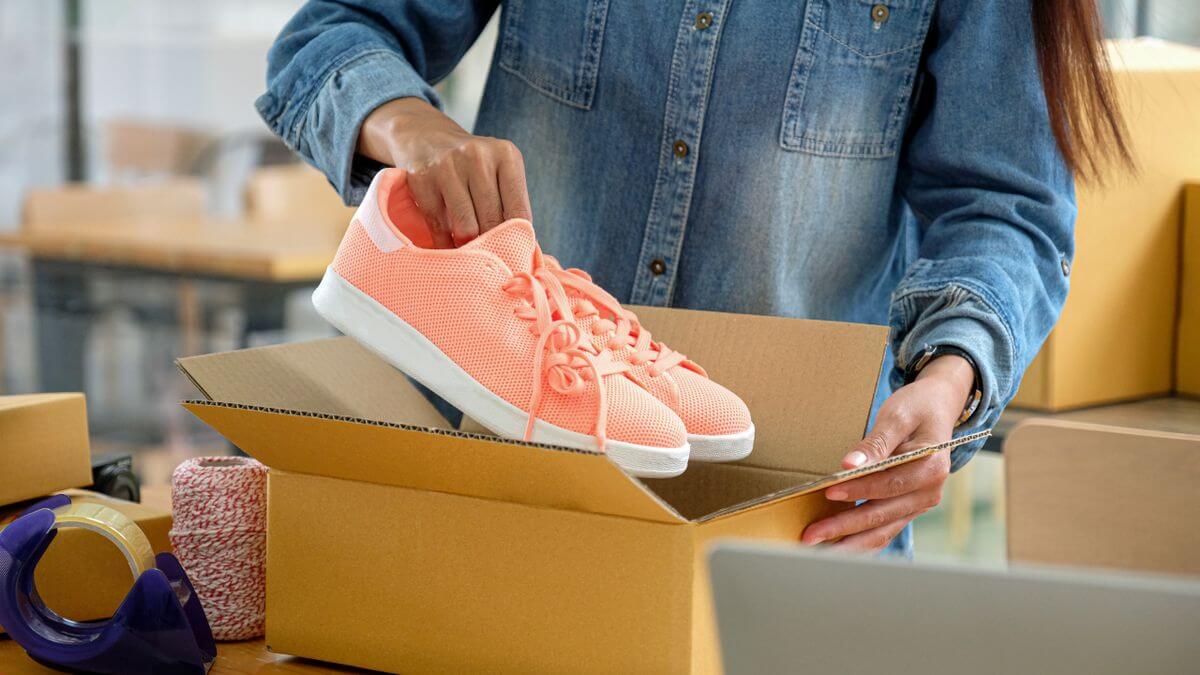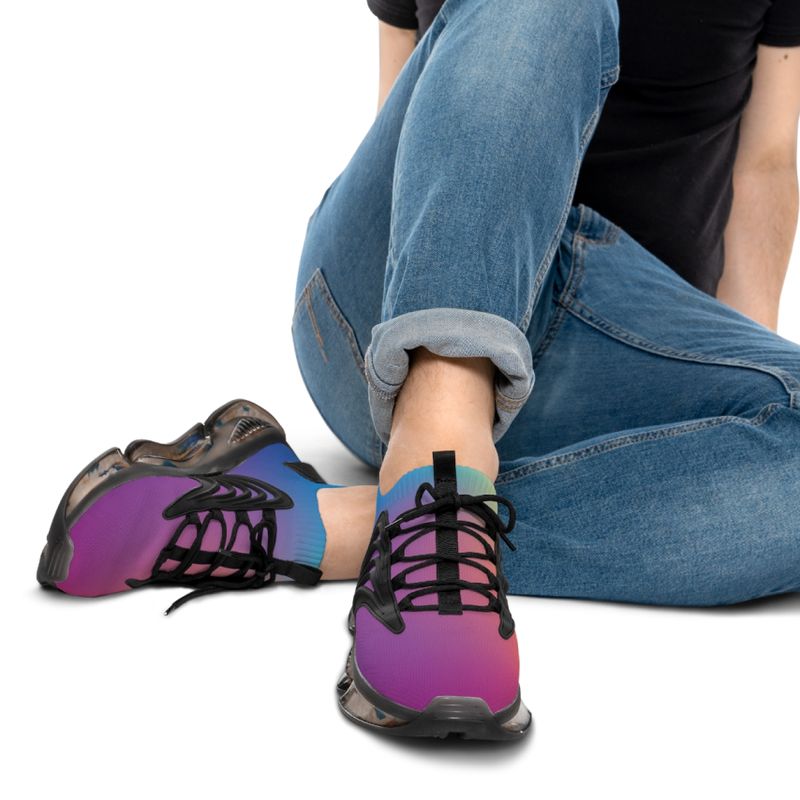Start a custom printing business with Printify
Starting a custom shoe business can be the source of income you’ve been looking for. The footwear market in the US alone answered for more than $78 billion in 2021 and should grow 5.88% annually by 2027.
This article will assist you in fulfilling the dream of creating your own shoe store, focusing on online sales. Learn how to start a shoe business, from planning to getting the final sample.
How to start your own shoe business in 10 steps
Becoming part of the most successful shoe stores will require planning, research, hard work, and the right partners. We summarized the process in ten steps, focusing on eCommerce and Print on Demand.
Learn more about print on demand and starting a print-on-demand business.
Step 1: Research the industry

Start with market research. You need a good idea of what other brands are doing in the shoe industry.
Study the competition and be aware of their strengths and weaknesses. What do they sell?
Research fashion trends, best-selling products, target market, location, and prices.
Look for shoe stores on marketplaces like Amazon, eBay, Etsy, and Walmart and type queries as “popular shoes” or “trending footwear.” Try out queries related to your target audience – for example, “trending athletic shoes for women.”
Read the product reviews and note what attracts customers and disappoints them.
Get inspiration from other shoe stores, but add your input and plan unique designs that add value to your target customers.
Repeat the queries from the marketplaces, pick the name of preferred products, and look for the terms in free tools like Google Trends.
Survey the related queries, demographics, and trends. Observe trends related to the products you’re planning to sell – do people look for them all year round, is there seasonality, are the queries increasing over time?
Step 2: Find the right niche
A niche is a specific, targetable segment of a larger audience. It’s a group of like-minded people with particular interests and needs. The narrower the niche, the better.
Defining a niche is essential to reach the right customers and offer custom shoes to answer their demands.
Use Google Trends and type keywords representing your unique selling proposition (for example, “artsy footwear for men”).
Look into the related queries, demographics, and locations. Understand who is looking for products similar to your shoe brand, and target them.
Learn more about niches and tools with our video:
Step 3: Choose your business model
The most crucial decision to make when starting a shoe company – what will your structure be?
Choose one of these three models for a shoe store:
- Ownership of production – you design and manufacture the shoes and control a good part of the supply chain, assuring quality control and customization. It requires detailed planning, funding, installations, technical capacity, and human resources.
- Wholesale – the shoe store buys products in bulk from a manufacturer, keeps them in a warehouse, and sells the footwear gradually. It demands costs with facilities, managing inventory, and business insurance.
- Dropshipping and Print on Demand – the way to start a shoe business without worrying about the shoe store’s startup costs. The shoe store is the intermediary between the final customer and the manufacturer. Focus on design, marketing, and communication while the print provider takes care of applying the designs, fulfillment, and managing inventory. The shoes are produced only when an order is placed in the online store.
Make it happen today!
Step 4: Develop your business plan

A business plan is a document describing the company’s goals and the methods and timeframe to achieve them. It’s a road map helping to structure and run your own business.
- Prepare a traditional business plan if you’re detail-driven and prefer to follow well-defined guidelines or intend to obtain financing from third parties for manufacturing your shoes. Include every detail, from the company’s structure and product line to financial projections and funding requests.
- Write a lean business plan if you intend to start a smaller shop quickly, if the business structure is simpler, or if you intend to adapt it on the road. It can be written visually as a chart containing fundamental elements, like the unique selling proposition, key activities and revenue streams, resources and assets, or partnerships.
Download templates to your shoe store from the US Small Business administration.
Step 5: Come up with your business name and brand
Your shoe store’s name and brand should reflect the products it sells. Whether the line focuses on luxury boots, artsy sneakers, or athletic shoes, the theme should reflect in the brand name.
A brand name must harmonize with its story. Why the shoe line is named as such, and what story is behind the brand and enterprise? Memorable stories will make a brand unique.
Besides that, ideally, a business name should be short, easy to remember, and not difficult to spell or type.
Online name generators assist in finding the perfect name for your brand. You can type keywords like “luxury shoes” or “minimalist,” and the generator suggests related business names.
Using the same name on your internet domain is a good SEO and marketing practice. So, after deciding on the brand name, check if there’s an available domain name using tools like DomainWheel or GoDaddy.
Finally, don’t forget about copyright and registering a trademark.
Step 6: Find a place for your shoe store and facilities

You have three possibilities to place your shoe brand – using a physical location, going fully online, or adopting a mixed approach:
- A regular retail shoe store requires physical locations with the accompanying requirements, such as renting, bills, operating costs, and business insurance.
- An online store is less expensive than a physical shop. It has a broader reach, and you can manage it anywhere.
- A business can maintain an online storefront while manufacturing the goods or keeping inventory. The store will have operational costs with a few physical locations in this case.
Ownership over quality control is the main advantage of owning the production and holding inventory. On the other hand, this is the more expensive way of starting a shoe business.
The best way to eliminate extra expenditure with facilities and go fully online is to opt for print on demand. Print providers will deal with the material costs, while the shoe store focuses on design and marketing.
The downside of POD is quality control. Be sure to find the right partner to guarantee consistent quality.
With Printify, you can create a new business online and sell shoes with builders like Shopify, BigCommerce, PrestaShop, WooCommerce, Wix, or Squarespace. You can also sell your shoe brand in marketplaces such as Etsy, eBay, Walmart, or Amazon.
Each one of these eCommerce platforms has costs with subscriptions, plugins, hosting, or fees. Still, they are more affordable than renting and keeping facilities and human resources.
Step 7: Register your footwear business
Registering a shoe brand differs depending on the country and state. If you’re not partnering with legal entities, you only have to register as an individual entrepreneur.
Usually, there are two main processes to solve in the US:
- Deciding the business type. The most common are:
- Sole proprietorship
- Partnership
- LLC – limited liability company
- Corporation
- Registering for taxes. There are two different types of registration required:
- Federal taxes – an Employer Identification Number (EIN) is necessary for accepting payments and filing taxes.
- State taxes – check your state website, as each state will have different procedures to be followed.
Registering an LCC and setting taxes can be easily done with the assistance of third parties, such as ZenBusiness.
If you create your shoe line with Printify and POD, our Help Center provides extensive FAQs about taxes for the US, EU, and Canada. Find information on registering and collecting sales taxes or lists and links to reputable companies that may assist when you file taxes.
Make it happen today!
Step 8: Create a business bank account and more
Create separate business accounts for everything connected to your legal entity.
Use a different bank account unrelated to your personal assets for your shoe store business. The same applies to a business credit card.
For creating a business bank account in the US, you’ll need:
- EIN or a Social Security number (in the case of sole proprietorship)
- Business license and other business registration documents
- Any ownership agreements (for partnerships and similar)
Acquiring business insurance is recommended to operate safely if you keep a physical inventory and mandatory if you have employees. Consult your bank on options provided by the institution, or get quotes from reputable insurance companies, like State farm, Hiscox, or Liberty Mutual.
Depending on the business model and state, you may need additional licenses and permits. Start looking on the city council if any essential document is missing according to city, county, or state requirements.
Create separate accounts for your shoe store when promoting on social media platforms. Most website builders will connect to social platforms.
Step 9: Decide what shoes to sell, design, and produce them
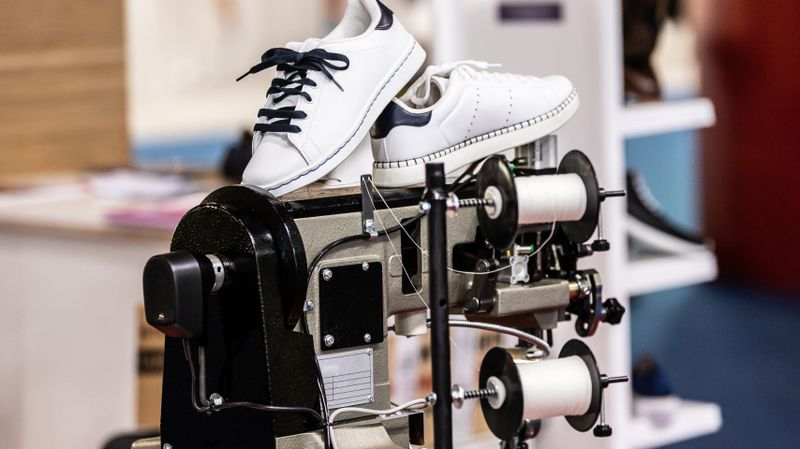
There are two distinct approaches to designing a shoe line:
- Manufacture the footwear from scratch. That will require designing the whole shoe, sourcing materials, manufacturing, and keeping an initial inventory.
- Focus on the design and outsource the production. Print on demand will allow you to create your shoe line in no time, with no upfront costs. Focus on designing and creating while print providers will produce and print the footwear.
Partnering with Printify will make that possible, as we have the largest network of Print Providers and a Catalog with over 900 unique products. Check out these in-depth comparisons, Printify vs Printful and Gelato vs Printify, and see for yourself. Here’s how to start a custom shoe business with no money using Printify:
Create a Printify account
Go to the Printify homepage, click Start selling, and create an account. Use a Google account or an email address. Sign in to Printify for free with unlimited products and up to five stores per account.
Small businesses can escalate with the Premium plan ($24.99 monthly billed annually), which offers up to ten stores per account and up to a 20% discount on all products.
The Enterprise plan, for merchants with more than 10,000 orders a day, offers unlimited stores, a 20% discount on all products, and custom pricing.
Integrate a sales channel
Choose the sale channel where you have an online shoe store. Printify integrates with Shopify, Etsy, eBay, PrestaShop, BigCommerce, Wix, WooCommerce, Squarespace, or a custom API.
Depending on the channel, you may be required to create a standalone website and pay for subscriptions. Shoe selling on marketplaces like Etsy and eBay will demand no such costs, although each listing on Etsy will cost $0.20 to be published.
Choose and design your custom footwear
Pick a shoe in our catalog and select the closest print provider.
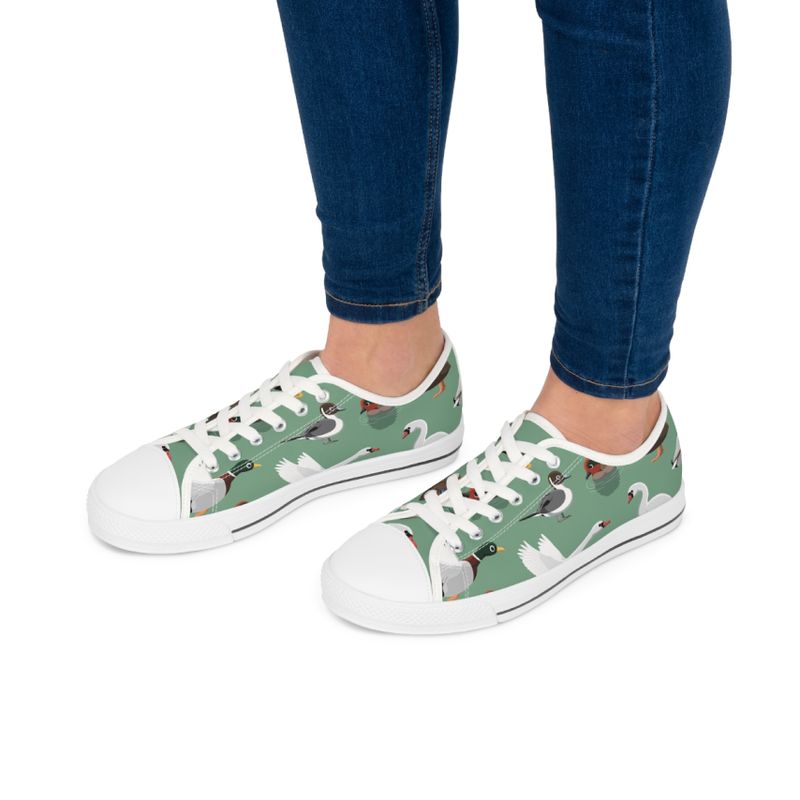
Fully customizable, order these classic sneakers with white or black laces and soles, while it’s possible to print different images on the left side, right side, and tongue.
The rubber outsole pairs with an EVA shock-absorbing layer and a hi-poly deodorant memory foam insole.
Men’s sneakers run bigger than usual – it’s suggested to size down.
- From $27.61
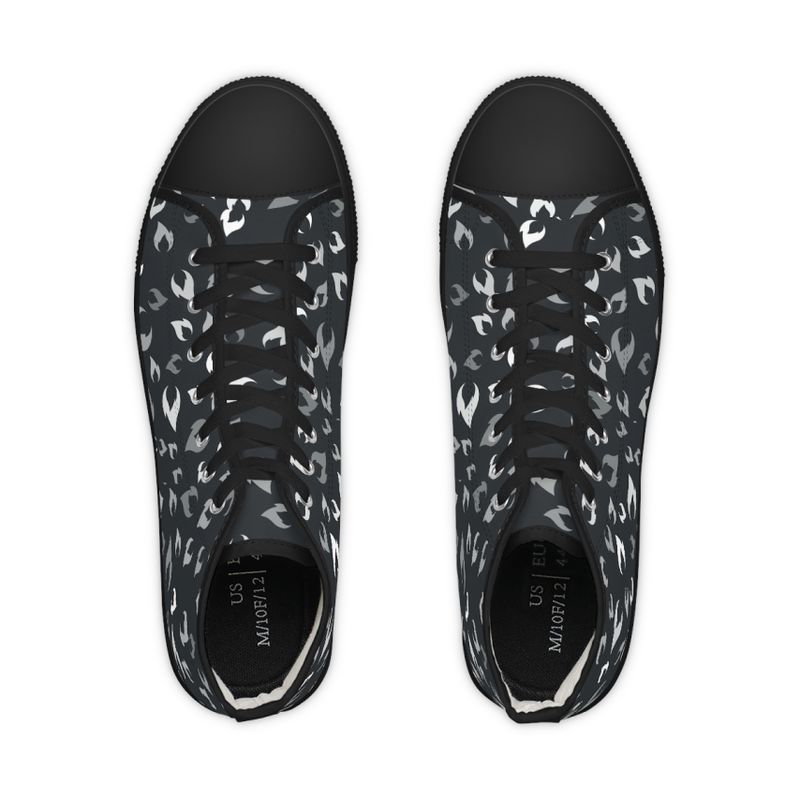
These classic high-top sneakers are fully customizable, can be ordered with white or black laces and soles, and can be printed differently on the left, right, and tongue.
They come with a rubber outsole, an EVA shock-absorbing layer, and a hi-poly deodorant memory foam insole.
- From $29.85

These 25.71 oz. nylon canvas sneakers are lightweight and comfortable. They come with a rubber outsole and a black interior. This canvas material is not suitable for small and detailed prints.
- For women – from $37.31
- For men – runs smaller than usual, suggested to size up. From $38.81.
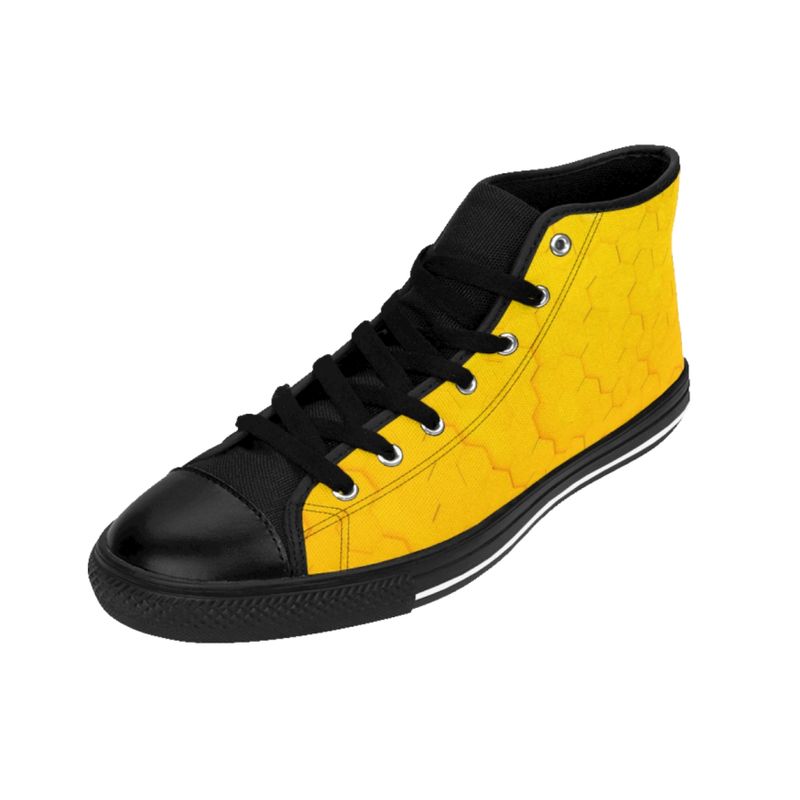
Slightly sturdier than the low tops, these sneakers retain comfort and style with a 27.87 oz. nylon canvas. The black inside interior accompanies a rubber outsole. The nylon canvas isn’t suitable for small prints.
For men, the sneakers run smaller than usual – we suggest sizing up.
- From $38.81
- Slide Sandals
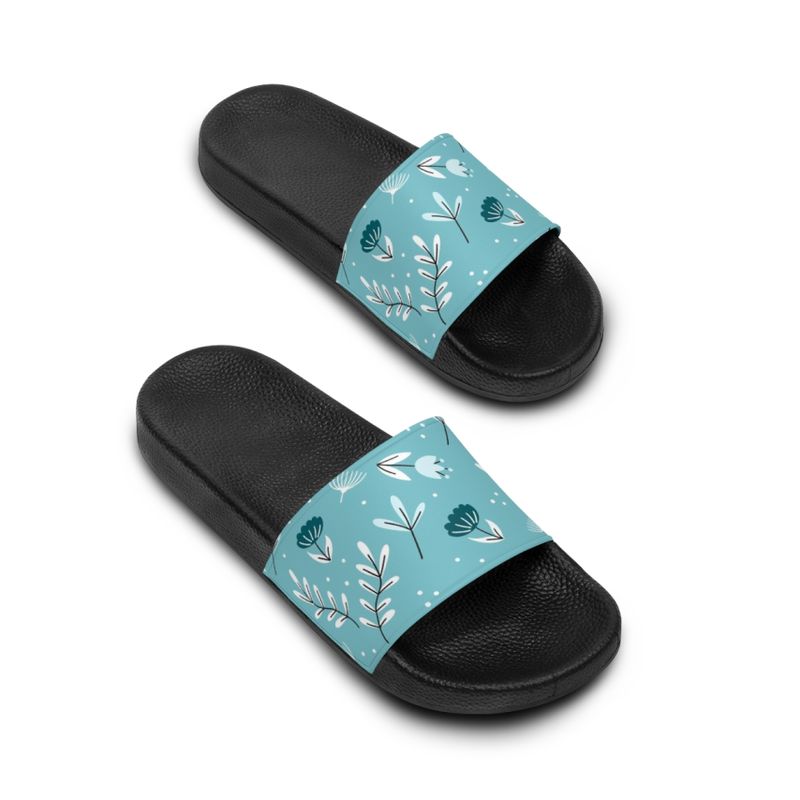
With outsoles made of durable PVC foam and quick-drying printable straps, these slide sandals are comfortable, durable, and customizable.
For wide feet, we recommend sizing up.
Want to go further? Check our options for custom slippers and flip-flops.
Publish and start selling
Use the Product Creator to customize the chosen footwear and apply designs by clicking Start Designing.
After applying your design and picking the colors, click Save product.
Now it’s time to edit the descriptions and define the profit margin. Use appropriate keywords when possible.
Finally, choose the main shoe’s mockup picture and color.
Once you’ve completed the designing and product creation, click Publish. The product will be displayed automatically in the integrated online shoe store.
Make it happen today!
Step 10: Develop an online marketing strategy for your shoe company

Digital marketing will be fundamental in promoting your eCommerce business and getting new customers. Explore the marketing resources offered by your eCommerce platform, especially the following:
- Social media is free. Create integrated business accounts for your shoe brand on several platforms to reach potential customers. Post consistently according to the platform’s audience, alternating between promotional posts and educational content explaining features of your brand.
Instagram reaches audiences younger than Facebook. Pinterest is an excellent place for online marketing, especially if you own an online store on Etsy. Consider TikTok, aiming to reach your niche.
Use social media to gather email addresses in exchange for promotional codes, coupons, or free ebooks, but be sure to ask permission before sending emails. - Use tools like Mailchimp to create email marketing campaigns. Mailchimp’s free plan gives a subdomain for free website building in a Mailchimp subdomain, analytics, campaigns, or automations.
Besides social media, get email addresses on your webpage, always trading them for something of value. Make it easier for the customers to subscribe with widgets on websites and buttons in Facebook shops.
Send promotional and informative emails. Informative emails let the customers know about order status and shipping and are usually automated by any eCommerce platform. Promotional emails can promote seasonal offers, inform of new products, or bring back lost customers. - Last but not least, optimizing SEO and content generates organic traffic. Research for keywords related to your target audience with Google Trends (see Step 2), and apply the keywords in every piece of content, from descriptions of products to alt texts and blog posts.
Different platforms will provide specific marketing possibilities. Stay in the loop with updated articles for:
- Creating ads for Facebook
- Improving Shopify’s SEO
- Boosting WooCommerce SEO
- Marketing strategies for Etsy
- Multichannel and Omnichannel marketing strategies
FAQs about starting a shoe business
The global footwear market is profitable, and there is no sign that it will slow down.
The US’s medium annual expenditure on footwear was $154.99 per woman and $107.23 per man in 2020. The footwear market in the US generated more than $78 billion in revenue in 2021.
It depends on the business model. While reselling from wholesale suppliers and creating your production line may require investments and initial inventory, creating a shoe line via dropshipping associated with print on demand requires minimal spending.
Follow these ten steps:
- Research the industry
- Find the right niche
- Write a business plan and determine the business structure
- Create a business name and brand
- Find a place for the shoe store or conduct the business online
- Register your business
- Create a business bank account and others required
- Design the shoe line
- Manufacture the footwear or outsource the production
- Develop and implement a marketing plan
Selling shoes online is profitable. In Q3 2022, the footwear market generated $381.90 billion in revenue. The market is projected to grow annually by 5.88% until 2027, with the percentage of online selling increasing annually.
Based on your niche, search for online shoe stores on marketplaces like Etsy. Pinterest boards are also a great place to look for ideas.
Associating dropshipping with Print on Demand allows you to start a shoe business with minimal investment.
Final thoughts
This article explained how to start a shoe business online. You learned the existing ways to manufacture footwear, how to do it without money, and strategies to sell shoes and create a customer base.
Now it’s up to you. Using Printify’s help, make your dream a reality and create your shoe store with print on demand.



